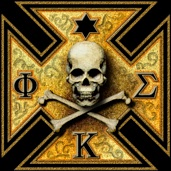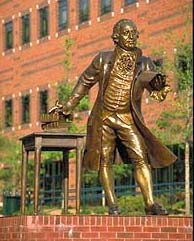Phi Kappa Sigma was founded by Samuel Brown Wylie Mitchell (pictured left) at the University of Pennsylvania on August 16, 1850.

in the restricted life of the university at that time. His papers indicate that on August 16, 1850, he had determined to install a new order on the campus in the fall of 1850.
Between August 16 and
October 19, 1850, Mitchell sought six other men to constitute the Alpha Chapter of Phi Kappa Sigma. The formal organization of the Alpha Chapter occurred at the home of James Bayard Hodge on October 19, 1850.
Mitchell, born August 16, 1828, attained a high level of achievement at the University, including earning B.A., M.A., and M.D. degrees. He spent a year as an assistant physician at Philadelphia Hospital and was responsible for supervising the Fraternity's growth at the University of Pennsylvania and the other schools where early chapters were established. Dr. Mitchell practiced medicine until he was commissioned on April 11, 1861, as a Major and Surgeon in the Union Army with the Eighteenth Pennsylvania U.S. Volunteers. He served with distinction until the expiration of his service on January 24, 1865. In March of the same year, Mitchell was made Lieutenant-Colonel U.S.V. for "gallant and meritorious service."
Dr. Mitchell was also an outstanding member of the Masons, and an active participant in the professional, social, cultural, and civic life of Philadelphia. James Chamberlain (likely the first pledge of the Alpha Chapter) wrote in 1850, "I remember with profound satisfaction and pleasure the kindly and genial appearance of our founder. A nobler man in ideas, sentiments, and character has rarely lived."
In the autumn of 1849, when Samuel Brown Wylie Mitchell matriculated in the sophomore class of the University directly after his graduation from Central High School in Philadelphia, the Delta Phi Fraternity established a chapter at the University of Pennsylvania. During the summer of 1850, a chapter of the Zeta Psi Fraternity established itself on campus. It is probable that the institution of chapters by these two social fraternities at the University of Pennsylvania inspired Mitchell to formulate in his own mind the ideals of a society that would emphasize good fellowship, pursuit of scholarly activities, and qualities of being a gentleman, all combined into a lifelong bond.

As soon as the school opened for the autumn session, Mitchell communicated his ideas to Charles Hare Hutchinson. Hutchinson was impressed with Mitchell's ideas and explained them to Alfred Victor du Pont, John Thorne Stone, Andrew Adams Ripka, James Bayard Hodge, and Duane Williams. It was these seven men, with Mitchell serving as their leader, who organized Alpha Chapter and officially founded Phi Kappa Sigma on the l9th of October, 1850.
Fraternities were not welcomed by faculties and administrators of many universities prior to the American Civil War. Many chapters were forced to exist sub-rosa or become extinct, as a result of the antagonism evidenced toward social fraternities. Along with other fraternities, Phi Kappa Sigma was banned from the University of Pennsylvania campus in 1852. Dr. Mitchell was called before the Board of Trustees and asked "Why do you wear that 'Piratical' ensign?" His answer was not recorded, but he must have been convincing since the fraternity was allowed to maintain a sub-rosa existence with headquarters in Mitchell's rooms at the Philadelphia Hospital, where he later served as Assistant Physician.
While the fraternity operated at the clandestine level, Dr. Mitchell and his fellow brothers established chapters at more receptive institutions. Princeton and Lafayette were added in 1853, and Jefferson (now Washington & Jefferson), Dickinson, Franklin and Marshall, and the University of Virginia were added in 1854. In the mid 1850's, the University of Pennsylvania rescinded its ban on fraternities and in January, 1855, Phi Kappa Sigma was officially recognized by the school. Meetings of the Chapter were held in rented chapter rooms, without dormitory or dining facilities, in various sections of downtown Philadelphia until 1896, when a house was purchased adjacent to the university campus in West Philadelphia.






